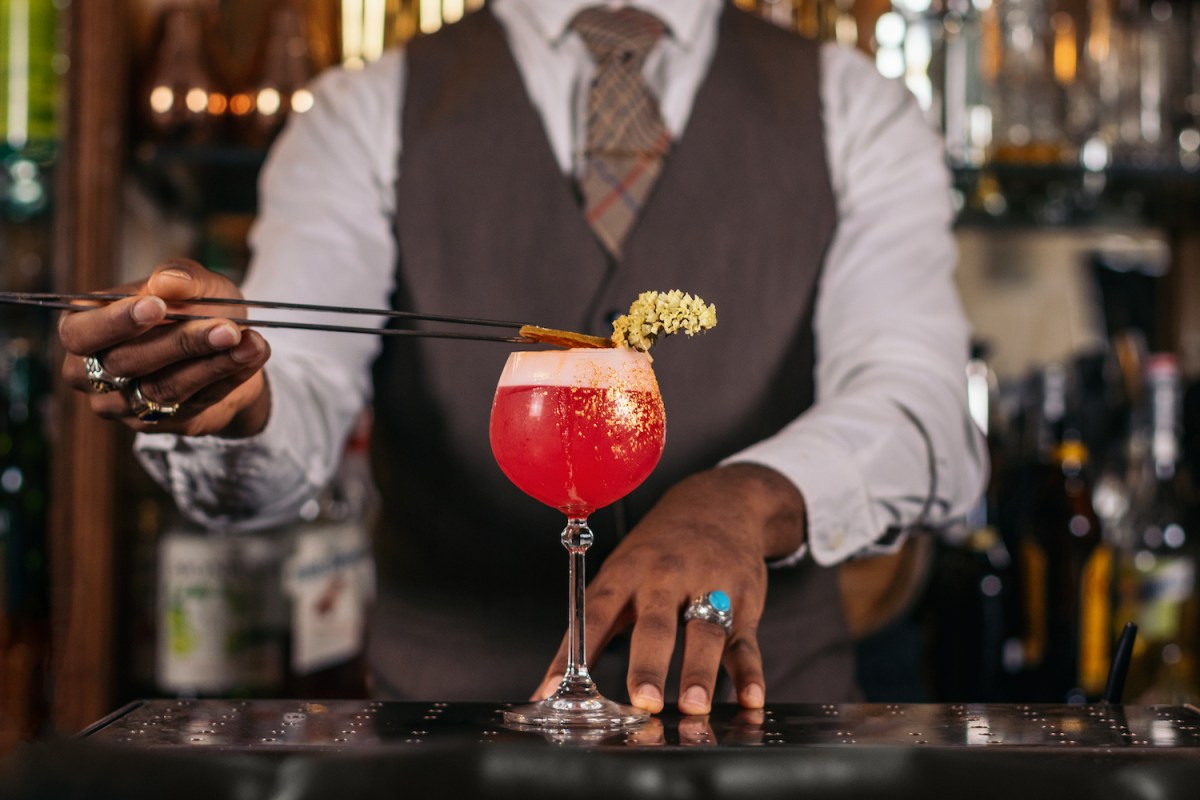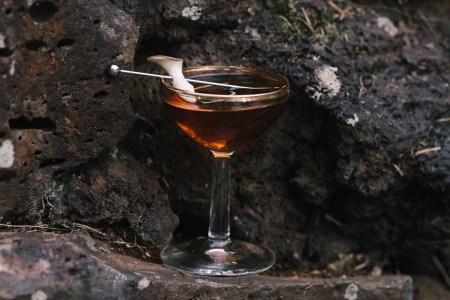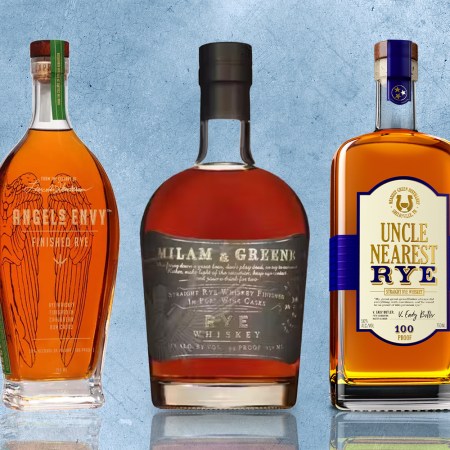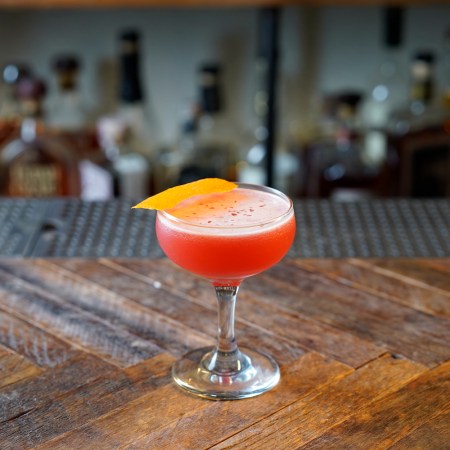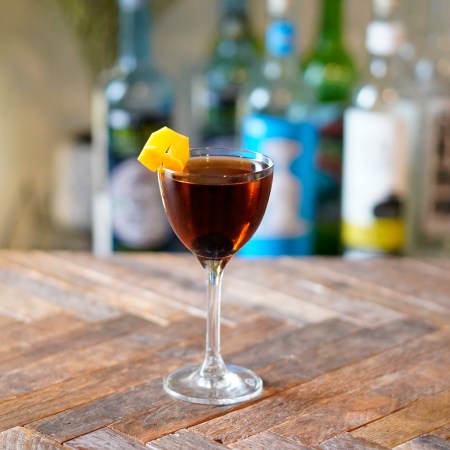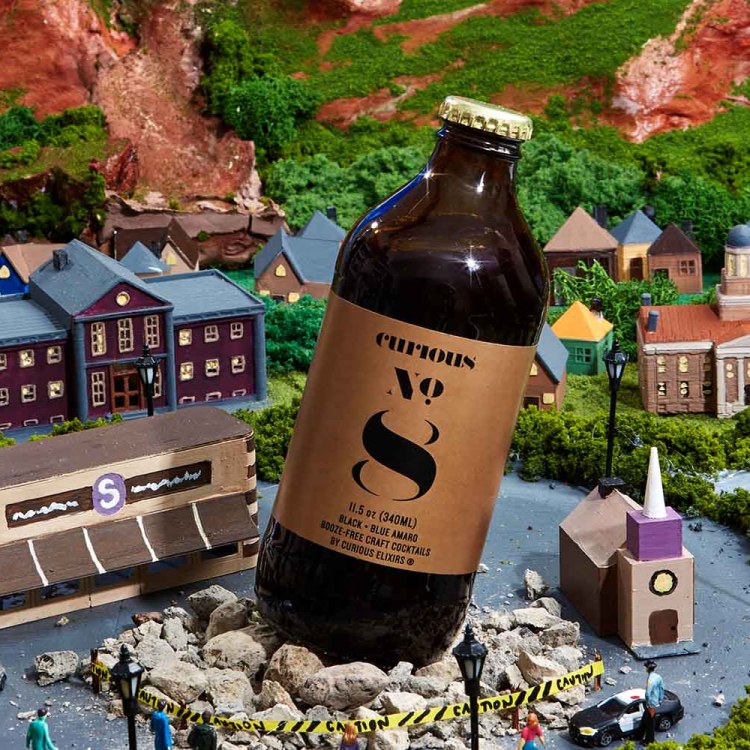The term “garnish” implies nothing more than a decoration, but cocktail garnishes are often important elements of the drink recipe, and have had a journey of different trends all their own. Over-the-top garnishes like flaming orange peels have accompanied cocktails since the 19th century, writes Robert Simonson for PUNCH. Around 2015, we saw a spike in maximalism thanks to the Instagramification of nearly every food and drink category — Bloody Marys precariously topped with entire meals, revealing that purveyors were so preoccupied with whether or not they could, they didn’t stop to think if they should. More low-key garnishes, too, have been a steady through line over the decades, part of the DNA of many classics. Would you even recognize your Martini sans olive?
More recently, garnishes like New York hotspot Double Chicken Please’s housemade chocolate-and-coffee “Oreo” for its French Toast drink prove how these elements can be a flex for artists behind the bar. And now, cocktail garnishes have their own entire debate raging — about whether they should exist at all.
This August, Lucy Simon’s “That Lemon Slice on Your Cocktail Is Contributing More Than Its Fair Share to Climate Change” for Food & Wine was a shot heard ‘round the cocktail-making world. Simon makes the argument that after years of garnish maximalism, plenty of bartenders and imbibers alike are craving more fuss-free drinks as it is, but that more importantly, many members of the bar industry are learning how wasteful garnishes can be. She points to a statistic that zero-waste spirits brand Discarded Spirits Co. ambassador Calum Fraser shared in a seminar during this year’s industry convention Tales of the Cocktail: “One kilo of waste from lemon garnishes amounts to about the same carbon emissions as a 20-minute journey in a car.” Simon adds that in most cases, too, these lemons have already traveled quite a long way from where they’re grown to where they crown your glass, so carbon emissions are built into the formula.
Jason Wilson’s response for Wine Enthusiast, “Is ‘No Garnish’ the New Paper Straw?” wonders where this stat comes from. So, we asked Fraser himself. He pointed to a BBC guide to cutting food waste that reports three kilograms (6.6 pounds) of food waste is equivalent to 23.3 kilograms (51.36 pounds) of carbon emissions, as well as reports on cars’ average carbon emissions, concluding one kilogram (2.2 pounds) of food waste produces 7.6 kilograms (16.7 pounds) of carbon dioxide equivalent; at 2017 levels, that is 63 kilometers (39 miles) worth of car emissions — so, actually about an hour’s ride. And then there’s the factor of the waste itself.
“Generally, a garnish going onto a drink is destined to end up in the bin, be that landfill or composting,” Fraser says. “A lime wedge, lemon slice or orange peel is not going to be consumed along with the drink.” He adds the potential factor of fruit being peeled for garnishes and then just thrown away, and that even edible garnishes can spoil. “Across thousands of bars, this has a big impact,” he adds.
All bars should be taking a beat to evaluate their ingredients and processes to see where they could possibly be more sustainable, and any step they can take toward cutting waste helps. But, are most bars really just throwing away the fruit they peel for garnishes? Compared to everything else going on behind the bar, just how big of an effect do garnishes really have? Should we not even be garnishing the drinks we make ourselves at home? Are we all planet-destroying goblins if we orange-peel our Negronis?
“I personally think it’s a little ridiculous,” says cocktail blogger and Instagrammer Katie Stryjewski. “Anything that starts a conversation about sustainability is good, but calling out garnishes specifically feels like cherry-picking an issue to make ourselves feel good for ‘fixing’ it.” For example, Stryjewski notes that the lemon stat doesn’t address that “far more lemon goes into cocktails than on top of them.”
“The whole conversation is a bit silly and self-congratulatory because restaurants in general are never going to be that eco-friendly, especially any that sell red meat,” says Konrad Kantor of New Orleans destination Manolito. “Water is running constantly, from washing dishes to bar tins — the greenhouse gases from beef alone. Whatever you’re doing not selling drinks with garnishes, it’s infinitesimal compared to something like buying meat.” Kantor agrees that this discussion is a good one to be having but garnishes are such a small part of what bars and restaurants can be doing to be more sustainable.
The truth, too, is that so many bars and restaurants are indeed taking a mindful approach to their garnishes, and not just chucking whatever they peel into the bin. “I have seen an increase in bar programs attempting to use the ‘throw-away’ scraps of many things and repurposing them to cut down on waste,” says Lindsay Dukes, general manager of Bar Marilou in New Orleans. “There is a lot you can get out of a single item if you know how to use it.”
Kantor points out that in general, the less eco-friendly path is usually the costlier one, too, and that doesn’t benefit any establishment. Whether the intentions are altruistic or about trying to keep the lights on in a notoriously cutthroat industry, many bars and restaurants already put lots of thought behind whether every drink on the menu actually needs a garnish, and how they can repurpose any ingredients they do use for garnishes considered necessary.
Mushroom Cocktails Are Everywhere. That’s a Good Thing.
There’s a fungus among us (at least in our drinks)In New York, The Wooly is newly opened, but beverage director and head bartender Nik Sparks is already applying a lifetime of inspiration he’s found from industry members’ efforts to cut food waste. “I grew up around restaurants,” he says. “My mom is an amazing chef and was adamant that we do our best to avoid waste at home. When I finally made my way to hospitality in my 30s, I was pleased to see that zero- or near-zero-waste was already at the forefront of people’s minds.” Sparks cites Ryan Chetiyawardana of Lyan Bars, Leanne Favre of Leyenda and Clover Club, Iain Townsend Griffiths of Empirical Spirits, and Renato Tonelli of Dante as having “really set a standard that many in the industry should be aspiring towards.”
What does that look like behind these bars? At Manolito, Kantor says they are conservative and don’t buy things that would only be used in garnishes — fruits get juiced to go into drinks and peeled for garnishes. Elsewhere in New Orleans, at the Four Seasons Hotel’s Chandelier Bar, assistant director of food and beverage Hadi Ktiri says the team avoids single-use plastics and over-ordering. “If a cocktail garnish is edible, reusable or biodegradable, it’s fine to use.”
At The Wooly, Sparks uses almost exclusively compostable and/or biodegradable garnishes. “We also make ample use of our dehydrator and do our best to make sure no garnish has a single use in our program,” he says. Award-winning New York bar The Dead Rabbit approaches drink construction holistically, expressing citrus twists’ oils on top of the drink to add flavor and aroma, and those peels come from fruit juiced for various cocktails.
Intentionality regarding how many ways one ingredient can be used is a popular methodology. At MACHETE in Greensboro, North Carolina, general manager Kevan Ash says, “I always make sure that if a drink is garnished with a dehydrated lemon wheel, it actually contains lemon in the cocktail.”
Wilson’s Wine Enthusiast comparison of the garnish debate to the paper straw debate is apt. Both are positive in that they can spark much-needed conversations about sustainability and prompt bars and restaurants to re-examine their processes. But alone, these components of menus can be small potatoes compared to broader issues — like, as Kantor mentioned, red meat — and also don’t need to sound an alarm when so many industry members are already taking strides to be as efficient as possible. In other words, no need to boycott bars garnishing their drinks.
Besides, any cocktail bar worth its reputation wouldn’t garnish willy-nilly, anyway. Throwing something on top of a glass without real thought about whether it’s truly necessary and whether it’s actually contributing something essential and positive to the drink is a rookie mistake.
“Cocktail garnishes should be added if they are a functional garnish for the drink, or not added at all,” says Kristie Sibley, senior director of food and beverage at The Kennebunkport Resort Collection in Maine. “Garnishes also add an aesthetic component to the drink, but they should always tie into the ingredients.”
Neal Bodenheimer, managing partner of CureCo. in New Orleans, agrees with this ethos. “We like everything to serve a purpose and we don’t want to build maximalist drinks, but garnishes can really impact a drink’s flavor and/or smell, so you really have to know the how and why.”
Understanding this common approach for bars can help us as patrons remember to seek out establishments practicing sustainable processes but not write a spot off because garnishes accompany some of the cocktails. It’s also a good way of thinking for our own home bartending. Remember, not every drink needs a garnish, but when a recipe calls for one or you want to riff, simply be mindful. Plus, as Sparks points out, home bartenders will never come close to the volume of drinks being made at a bar, so one garnish here and there (most likely pulled from something you’re using in some other way) doesn’t require much second-guessing.
“My best advice is just be intentional and do not spiral into an existential crisis because you used a cocktail umbrella in a single drink,” Sparks says. “If you are going to make a Martini with a lemon twist, try to incorporate lemon juice into your meal or next drink. For drinks that already have a fair amount of citrus in them, like a Margarita or Daiquiri, try to avoid the garnish entirely.”
For those of us with the space and time, wanting to experiment with garnishes is a great bridge into another activity: gardening. Take a page from Stryjewski’s book and grow your own edible flowers and herbs. Another good tip from the cocktail Instagrammer? Relax — a little, at least. This discussion is positive and necessary, but there’s a bigger picture to remember.
“I do think it’s important to not be too hard on ourselves and allow ourselves to enjoy little things like pretty garnishes every now and then,” Stryjewski says. “Large companies in other industries contribute disproportionately to waste and emissions, and it makes me so sad to see small business owners debating the morality of a lemon wedge while that remains the case. But it is the kind of care and conscientiousness that I have come to expect from this wonderful industry.”
Every Thursday, our resident experts see to it that you’re up to date on the latest from the world of drinks. Trend reports, bottle reviews, cocktail recipes and more. Sign up for THE SPILL now.
